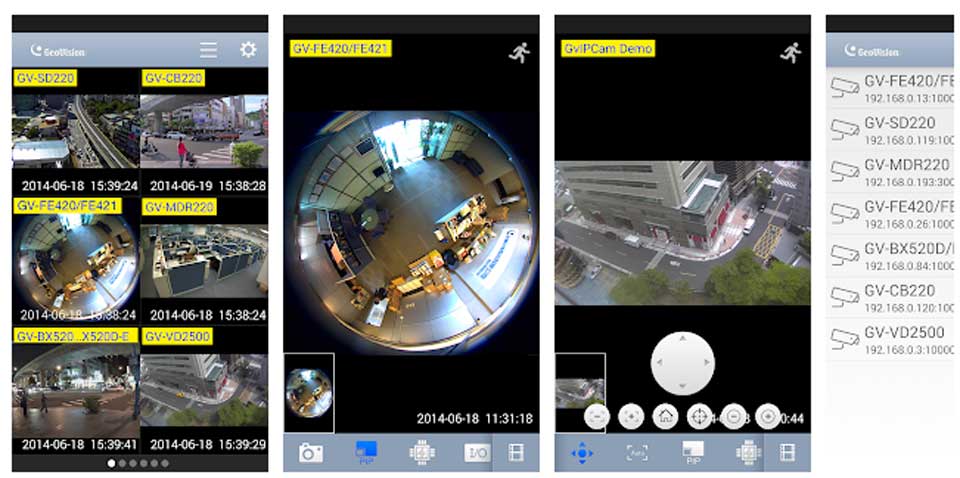GV-Eye Installation Guide, With GV-Eye mobile app, you can connect to GeoVision IP devices and software from your iOS or Android mobile devices to remotely watch live view, play back recordings, trigger outputs, take snapshots and more.
GV-Eye

Using GV-Eye, you can access GV-IP devices and software from your mobile devices, to watch live views, play back recordings, trigger outputs, take snapshots and more.
IMPORTANT: Starting from GV-Eye V2.7, users can connect to GV-VMS (V17.4 / V18.1 or later), GV-DVR / NVR (V8.8.0 or later) and GV-Recording Server / Video Gateway (V2.0.0 or later) via GV-Relay QR-code. This is a paid service that results in connecting to GV-SNVR via QR-code scan to be charged as well.
Read Next :
- ClareVision App Guide
- Tiandy Easy7 Smart Client Express User Manual
- Night Owl X CMS Installation Setup
General
| Supported OS | iOS 13 ~ 16.3; Android 8 ~ 12 |
| Codec | MPEG4, MJPEG, H.264 and H.265 |
| Resolutions | Up to 12 MP (4000 x 3000) |
| Functions | 360° Mode, Live View, PIP (Picture-in-picture), Fisheye Dewarping, PTZ Control & Preset, Remote Playback, I / O Output trigger, Snapshot, 2-Way Audio, Stream Switching, Device Search, Hardware Decoding, Add via QR code |
| Languages | English, Japanese, Traditional Chinese |
| Note: Mobile devices need to support 64-bit ABI (arm64-v8a) to install GV-Eye for Android V2.9.1 or later. | |
Default Port Settings
Below is a list of default port for GeoVision services that are used for remote connection.
| Service | Connection Port | Playback Port |
| GV-IP devices (VSS Port) | 10000 | 5552
80 |
| GV-Recording Server / Video Gateway Server | 11000 | 5552 |
| GV-Mobile Server | 55000 | N/A |
| GV-VMS | 56000 | 5552 |
You can download GV-Eye from the App Store or Google Play and install the application.
Upon first-time startup, you will be directed to a dialog box to enable or disable Demo Mode. Select Yes to enable Demo Mode to be guided through the key features of GV-Eye. Select No to disable Demo Mode and the main page appears.
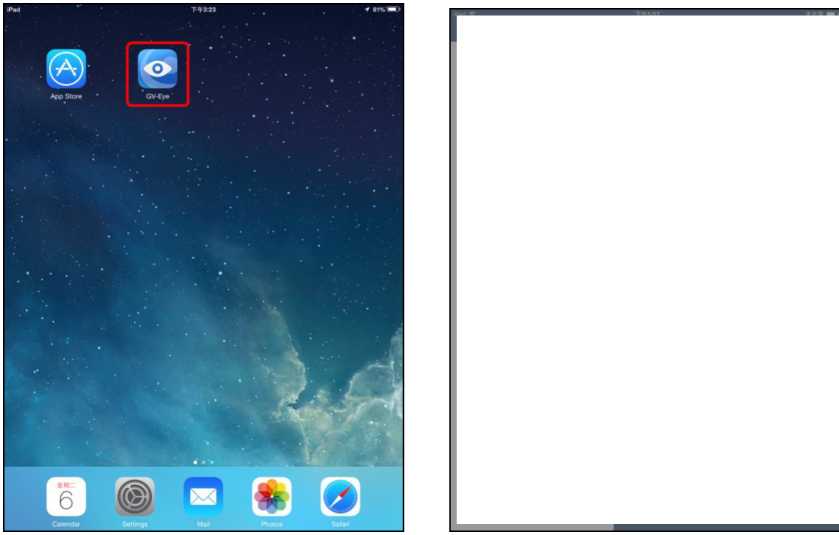
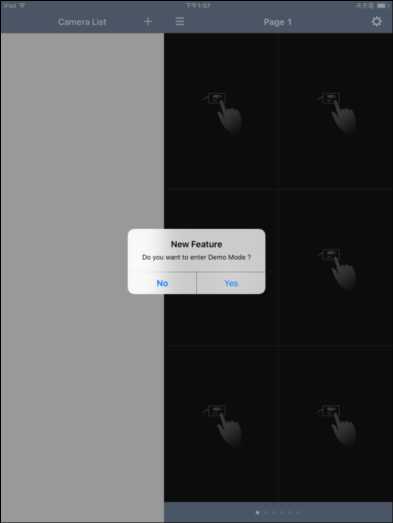
GV-Eye icon on iPad
Dialog Box of Demo Mode on iPad
The following main page of General Mode is exemplified using an iPad. The main page is set to be General Mode by default.
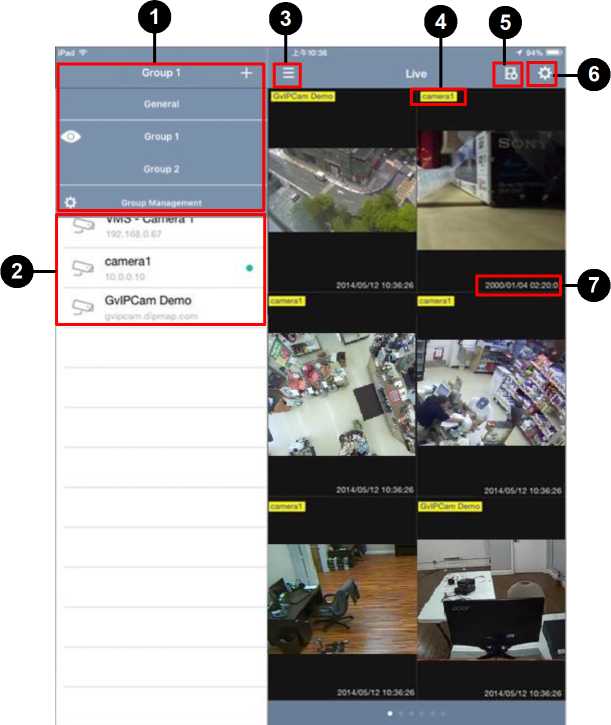
| No. | Name | Function |
| 1. | Group List | Manages groups for GV / UA-IP devices. For details, see 7. Group Management. |
| 2. | Camera List | Adds and removes connections to GV / UA-IP devices and software. Depending on the type of connection desired, see 5. GV-Relay QR Code and / or 6. Manual & Automatic Connection for GV-IP Devices and Software. |
| 3. | Full Screen | iPads and Android Tablets: Opens and closes the Camera List.
iPhones, iPod Touch and Android Phones: Opens the Camera List. |
| 4. | Device Name | Displays the device name, which turns red during recording. |
| No. | Name | Function |
| 5. | Edge Setting | Configures IP address and recording storage path of the device. |
| 6. | Settings | Tap this button to access the GV-Eye settings. For details, see 11. System Settings. |
| 7. | Device Time | Displays the device time. |
To quickly access real-time images of all channels for individual hosts, tap Settings and enable Easy Mode. Optionally, click Migrate to EZmode to load the camera data from General Mode.
When Easy Mode is enabled, tap the device you wish to display the camera channels from.
The live view is shown as below, exemplified using an iPad.
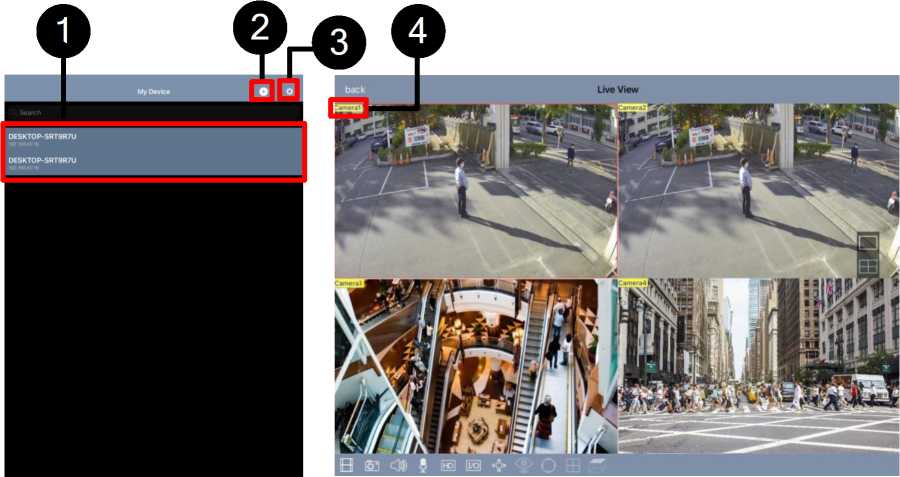
| No. | Name | Function |
| 1. | Device List | Displays and manages GV- / UA-IP devices and software. Swipe right to refresh, configure, or delete the specified device / software. |
| 2. | Add Device | Adds IP devices and software. Depending on the type of connection desired, see 5. GV-Relay QR Code and / or 6. Manual & Automatic Connection for GV-IP Devices and Software. |
| 3. | Settings | Tap this button to access the GV-Eye settings. For details, see 11. System Settings. |
| 4. | Device Name | Displays the device name, which turns red during recording. |
Note: Swipe right on the live view images to access all channels on different pages.
GV-Eye can be connected to GV-IP devices and software under the same LAN, through the Internet or by scanning of the GV-Relay QR code. The following sections focus on connecting by GV-Relay QR-code, which avoids the precondition of configuring for Windows Firewall and port forwarding. To do this, the binding of a GV-Relay account is required, see 5.1 Setting up GV-Relay Account.
Note:
- This function is only supported by GV-DVR / NVR (V8.8.0 or later), GV-VMS (V17.4 / V18.1 or later), GV-Recording Server / Video Gateway (V2.0.0 or later), GV-SNVR0411 (firmware V2.00 or later), GV-SNVR0811 (firmware V2.30 or later), GV-SNVR1600 (firmware V1.20 or later), GV-SNVR0812, GV-SNVR1611, GV-SNVR1612, GV-SNVR3203, GV-SNVR6403, and UA-DVR / SNVR.
- The GV-Relay data is a paid service and if users don’t want to purchase data after the free quota given is used up, they may connect manually, see 6. Manual & Automatic Connection for GV-IP Devices and Software.
- All images streamed via GV-Relay QR-code connection shall consume the data within the GV-Relay account according to their resolutions and fps, and you won’t be able to access such streams once the data is used up.
- To use this function, the GV-Software must be connected to the Internet.
- To connect manually or detect for GV-IP devices under the same LAN, see 6 Manual &
Automatic Connection for GV-IP Devices and Software.
For connecting by the QR-code scan, you must first set up a GV-Relay account. To do this, tap □ on the main page to access the settings page and tap Add a binding account under Account Management. The following page appears.
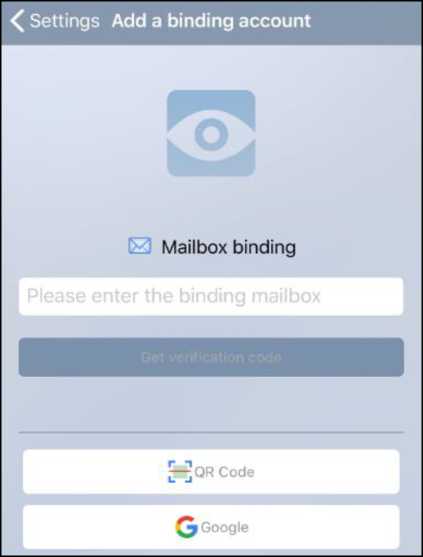
- Type a valid e-mail address under Mailbox binding to use it as your GV-Relay account.
- Tap Get verification Code. The Email verification page appears.
- Upon receiving of the verification code, enter the 4-digit code within its validity period of 10 minutes, as illustrated below and tap verification.
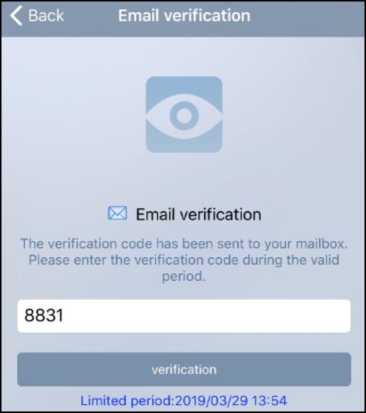
- Alternatively, tap Google to log into your Google account.
- Once successfully bound, the e-mail or Google account is used as your GV-Relay account and tracks the amount of data available, for viewing images through relay.
Note: All GV-Relay accounts are given 10.00 GB of free data every month and additional data can be purchased as desired, see 5.3.1 Purchasing Relay Data.
To connect to GV-Software by scanning GV-Relay QR code, see 5.2 Connecting via GV-Relay QR Code.
To manage your GV-Relay account, see 5.3 Managing GV-Relay Account.
You can connect to GV-Software or devices by scanning its GV-Relay QR code. To do this, follow the steps below.
Note:
- For connecting by the QR-code scan, you must first set up a GV-Relay account, see
- Setting up GV-Relay Account.
- To use this function, the GV-Software or devices must be connected to the Internet.
- For the list of GV-Software or devices supported, refer to Note 1 in 5. GV-Relay QR
Code
1. On the GV-Software or device, go to its corresponding service / settings page, as described below:
- For GV-VMS, click Toolbar > Network > Mobile Server > QR Code, select Enable and click Start. By default, GV-Relay uses the port value of 443.
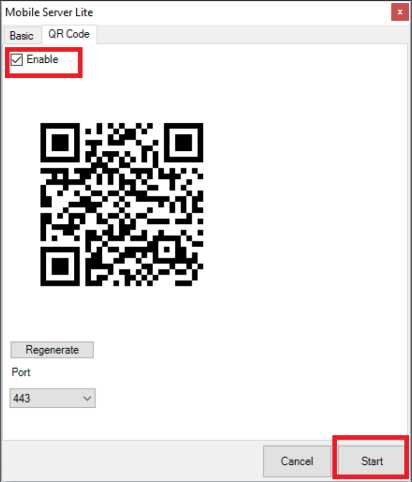
Note: When port 443 has been used by other servers, such as for WebCam SSL or RTSP, select port 9443 for GV-Relay connection instead.
- For GV-DVR / NVR, click Network > Webcam Server > QR Code, select Enable and click OK for the changes to take effect. Note that the Mobile Server (Webcam Server > Mobile) must be enabled first. Once enabled, close the dialog box and scan the QR code within WebCam, which can be accessed via Windows notification.
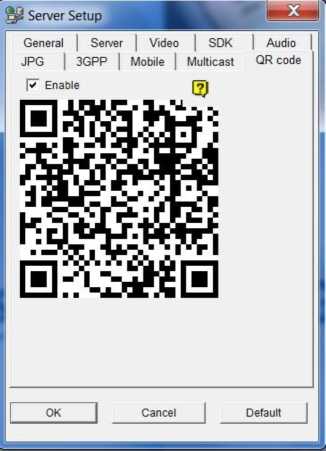
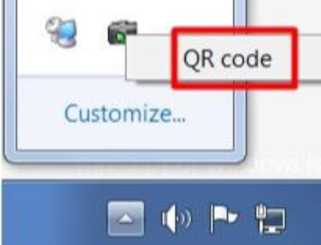
- For GV-Recording Server / Video Gateway, click Server > Video Gateway, select Yes to enable Video Relay and click Save for the changes to take effect.
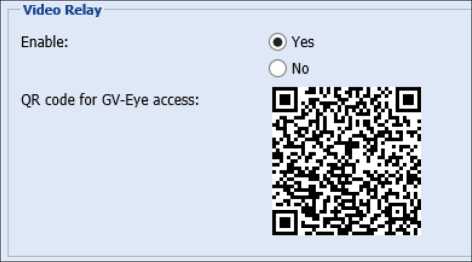
- For GV-SNVR0400F/0411/0811/0812/1600/1611/1612, click Setting > Service >
Mobile APP, select Enable and click Apply for the changes to take effect.
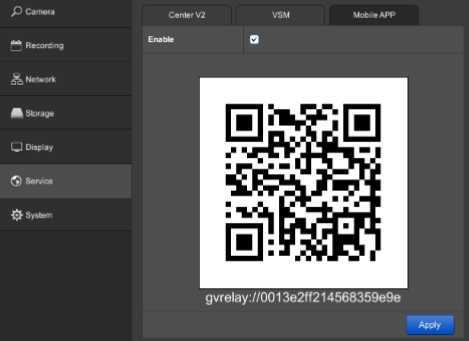
- For GV-SNVR3203/6403, click Network > Basic > Mobile APP. The QR code is shown as below.
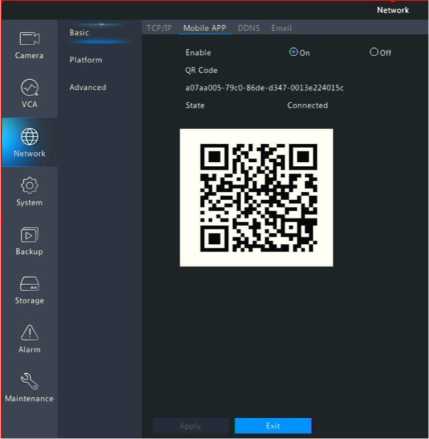
- For UA-DVR / SNVR, click System > Information > Information. The QR code is shown as below.
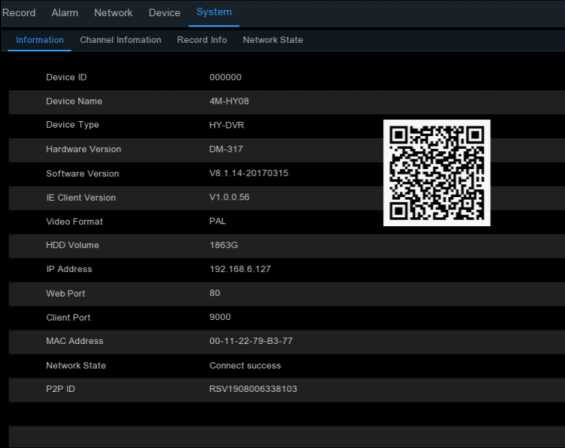
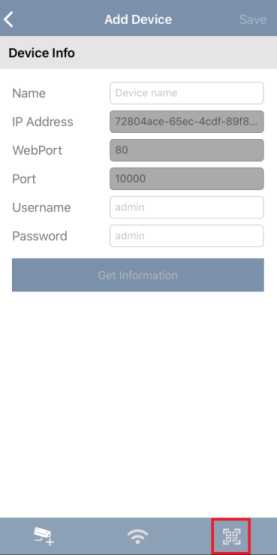

2.
3.
Device page.
Tap Add on the Camera / Group List page (No. 3, 4 Main Page) to access the Add
Tap QR-code scan . The QR code reader appears.
- Hold your device over the QR code on the GV-Software to the point where the QR code is clearly visible. When the scanning is successful, the following page appears. Type a desired Name and the login Username and Password of the GV-Software and tap Get Information.
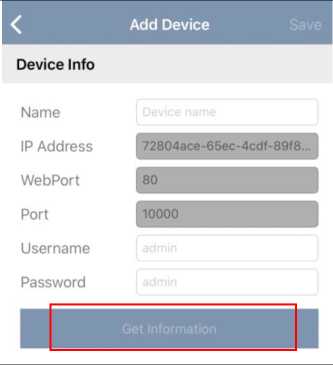
- All IP devices from the GV-Software are displayed. Select the devices you want to be
imported to GV-Eye and click Save.
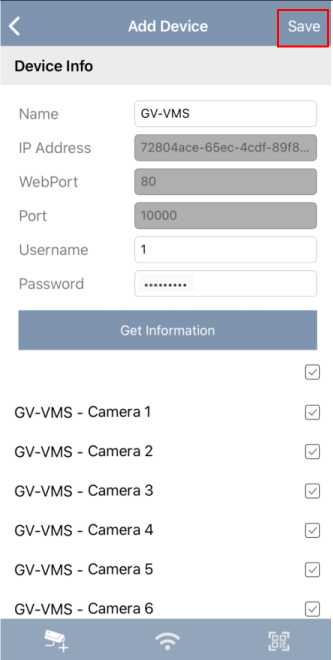
All of the selected IP devices are added to the GV-Eye under a Host Group.
When you are logged into your GV-Relay account, the following Account Management page appears.
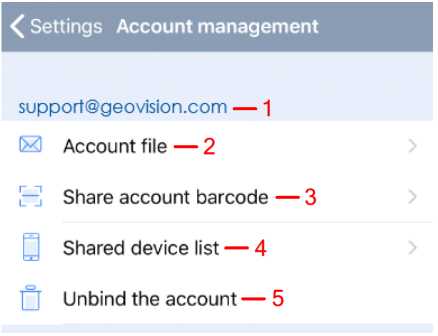
| No. | Name | Function |
| 1. | Account name | Displays the GV-Relay account currently logged in. |
| 2. | Account file | Tap to view the amount of data on the GV-Relay account and/or purchase data. See 5.3.1 Purchasing Relay Data. |
| 3. | Share account barcode | Tap to display a QR code for sharing the account’s data to other mobile devices. See 5.3.2 Sharing Relay Data. |
| 4. | Shared device list | Tap to display all mobile device(s) using the data of the GV-Relay account logged in. See 5.3.2 Sharing Relay Data. |
| 5. | Unbind the account | Tap to log off the GV-Relay account. |
To purchase data, tap Account file (No. 2, 5.3 Managing GV-Relay Account) and Shopping
cart . The Purchase page appears.

Tap the Shopping cart V next to the amount of data you want to purchase.
The data of a GV-Relay account can be shared to other mobile devices for GV-Relay streaming on those devices. To share the data from device A to device B, follow the steps below:
- On device A, tap Share account barcode (No. 3, 5.3 Managing GV-Relay Account) The Share account QR code, with its validity period, appears.
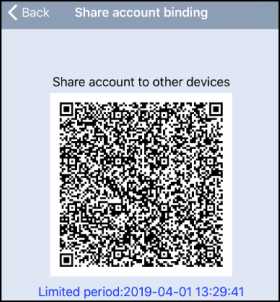
- On device B, start GV-Eye and tap □ > Add a binding account and tap the QR Code button l~ .
- Scan the QR code from Step 1 using device B. Once successfully scanned, the data from device A is shared to device B.
All images streamed by GV-Relay connection on both device A and B will consume the data from device A.
Removing Shared Device(s)
To remove a shared device, tap Shared device list (No. 4, 5.3 Managing GV-Relay Account) and select the account you want to remove.
Software
GV-Eye can be connected to GV-IP devices and software under the same LAN or through the Internet.
Note:
- To connect by the GV-Relay QR code, see 5. GV-Relay QR Code.
- If the GV-IP Devices and/or software to which you want to connect isn’t behind a Windows Firewall or router, the related settings may be skipped.
Refer to the following sections according to the type of connection needed:
For GV-Software / SNVR
| Configure for Remote Connection | If behind Windows Firewall | |
|---|---|---|
| See 6.1 Configurations on GV- Software before Connecting | See 6.2 Configuring
Windows Firewall for Communication |
| See 6.5 Automatic Connection | ||||
|---|---|---|---|---|
| ¿Via LAnJ | ||||
| J If behind a router “ | J Via “Internet | |||
| See 6.3 Port Forwarding | See 6.4
Manual Connection |
|||
For GV-IP Devices

See 6.2 Configuring Windows Firewall for
Communication
See 6.3 Por Forwarding
See 6.4 Manual Connection
6.1 Required Configurations on GV-Software before Connecting
For GV-Software to be accessible by GV-Eye, the related services and the corresponding port(s) must first be enabled. Refer to the following sections depending on the type of GV-Software in which you want to connect:
- For GV-VMS, see 6.1.1 Connection Settings on GV-VMS
- For GV-DVR / NVR, see 6.1.2 Connection Settings on GV-DVR / NVR
- For GV-Recording Server / Video Gateway, see 6.1.3 Connection Settings on GV-Recording Server / Video Gateway
Note:
- There are no required configurations for GV-SNVR to be accessible by GV-Eye. If the GV-SNVR is behind a router, see 6.3 Port Forwarding and 6.4 Manual Connection, respectively, for connecting to GV-Eye through the Internet. Otherwise see 6.5 Automatic Connection for connecting to GV-Eye within the same LAN.
- While there are also no required configurations for GV-Mobile Server, if it is behind an active Windows Firewall, make sure its mobile service is allowed for communication. See 6.2 Configuring Windows Firewall for Communication.
- On your GV-VMS, click Home > Toolbar ÉS > Network on > Mobile Service.
The Mobile Server Lite dialog box appears.
- Keep the default Server Port of 56000 or modify if necessary and click Start.
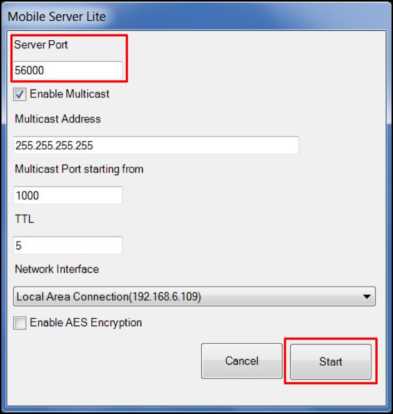
- Click Home kiJ > Toolbar bS > Network rt to make sure Mobile Service is
enabled, and optionally click Control Center Server and enable Remote ViewLog
Service to allow remote playback through GV-Eye.
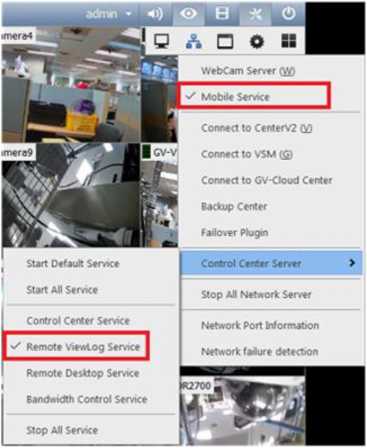
IMPORTANT: After the abovementioned settings are set, if the PC has an active Windows Firewall, the related services must also be enabled on the Windows Firewall for GV-VMS to be accessible by GV-Eye. See 6.2 Configuring Windows Firewall for Communication.
- On the main screen of GV-DVR / NVR, click Network and select Webcam Server. The Server Setup dialog box appears.
- In the Mobile tab, select the upper-left checkbox to enable mobile service and its corresponding ports. Keep the default Stream Port of 56000 or modify if necessary.
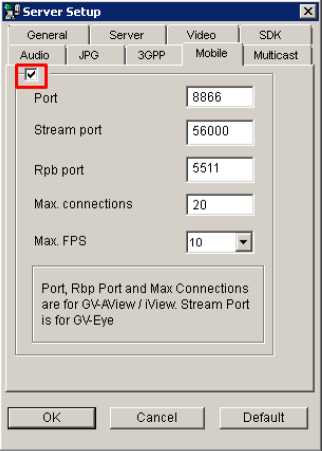
- Optionally select Run ViewLog Server in the General tab to allow remote playback through GV-Eye.
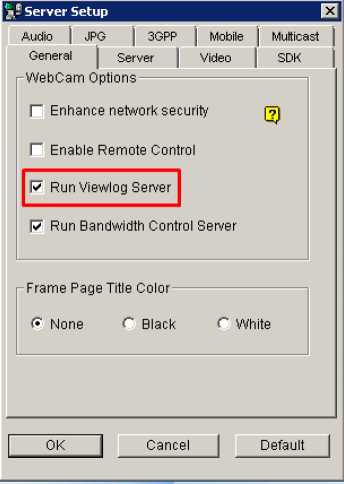
- Click OK. The GV-DVR / NVR can now be added to GV-Eye.
IMPORTANT: After the abovementioned settings are set, if the PC has an active Windows Firewall, the related services must also be enabled on the Windows Firewall for GV-DVR / NVR to be accessible by GV-Eye. See 6.2 Configuring Windows Firewall for Communication.
For GV-Recording Server / Video Gateway to be accessible by GV-Eye, its Recording Server and Video Gateway services must first be enabled. Note that these two services are enabled by default.
- On the main screen of GV-Recording Server / Video Gateway, click Server > Service
©. This dialog box appears.
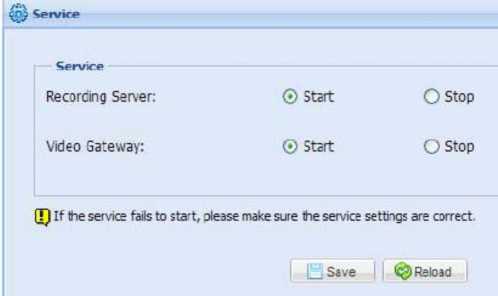
- Make sure Start is selected for both Recording Server and Video Gateway and click Save.
- Optionally click Server > Video Gateway ® to change the Connect Port,
otherwise keep its default value of 11000.

- Click Save. The GV-Recording Server / Video Gateway can now be added to GV-Eye.
IMPORTANT: After the abovementioned settings are set, if the PC has an active Windows Firewall, the related services must also be enabled on the Windows Firewall for GV-Recording / Video Gateway to be accessible by GV-Eye. See 6.2 Configuring Windows Firewall for Communication.
6.2 Configuring Windows Firewall for Communication
For GV-Software installed on a PC with active Windows Firewall to be accessible by GV-Eye, the related services / programs must first be enabled:
- Open Control Panel from the Windows Start menu, click System and Security >
Windows Firewall and click Allow a program or feature through Windows Firewall.
The Allowed Programs dialog box appears.
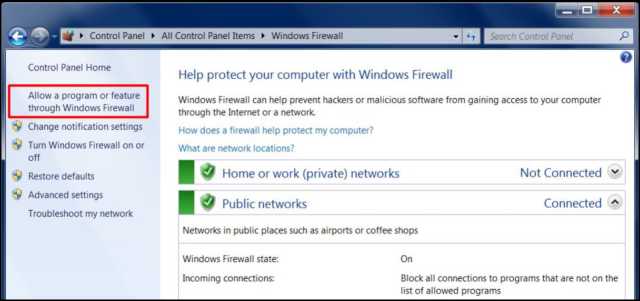
- On the Allowed Programs list, select to allow the related services / programs depending on the type of GV-Software to which you want to access.
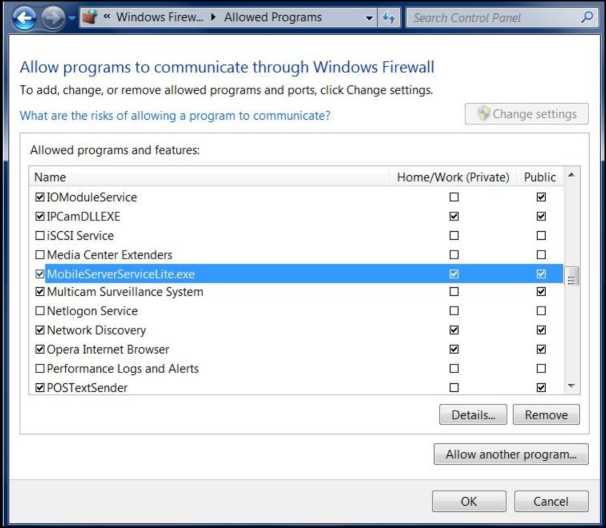
- For GV-VMS / DVR / NVR, allow GeoRSWLite.exe, MobileServerServiceLite.exe and ViewLog Server for both private and public networks.
- For GV-Recording Server / Video Gateway, allow GeoRecordingServer.exe and ViewLog Server for both private and public networks.
- For GV-Mobile Server, allow GeoRSWLite.exe and MobileServerServiceLite.exe for both private and public networks.
- Click OK. The GV-Software can now be communicated through Windows Firewall.
Note:
- If any one of the above programs cannot be found within the list, click Allow another
program… > Browse and:
- For GV-VMS / DVR / NVR, locate GeoRSWLite, MobileServerServiceLite and Vlsvr
from the GV-VMS / DVR / NVR’s directory.
- For GV-Recording Server / Video Gateway, locate GeoRecordingServer and Vlsvr
from the GV-Recording Server / Video Gateway’s directory.
- For GV-Mobile Server, locate GeoRSW and MobileServerServiceLite from the
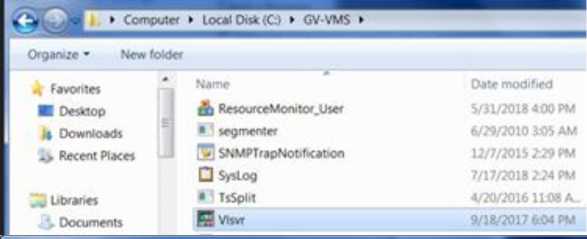
![]()

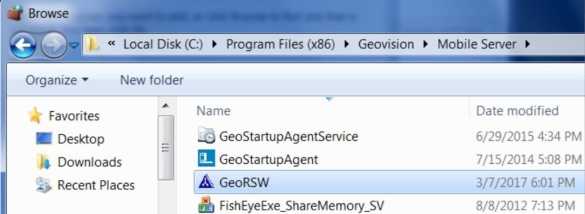
GV-Mobile Server’s directory.
Organize
New folder
Name
Date modified
9/30/2017 2:02 PM
1/3/2017 6:40 PM
7/2/2018 2:54 PM
11/2/2010 12:07 PM
■ Desktop Downloads Recent Places
Æ GeoInfoTransporter & GeoNotificationServer IJl GeoRecordingServer
GeoRSSiuAdapter
- If the GV-Software is behind a router, see 6.3 Port Forwarding and 6.4 Manual Connection, respectively, for connecting to GV-Eye through the Internet. Otherwise see 6.5 Automatic Connection for connecting to GV-Eye within the same LAN.
If the GV-IP devices and/or software to which you are trying to connect are behind a router, you need to configure for port forwarding.
IMPORTANT: Prior to port forwarding, first make sure you have a public IP accessible through the Internet. This can be done by one of the following:
- Register for a static public IP address from your Internet Service Provider (ISP).
- Assign a domain name to your dynamic public IP address through the router’s DDNS settings. Consult your router manufacturer for details.
- For port forwarding depending on the brand and model of your router, click here.
- Make sure the ports mapped coincide with the GV-IP devices and software to which you
want to connect:
| Default Connection
Port |
Default Playback Port | |
| GV-IP devices (VSS Port) | 10000 | 5552
80 |
| GV-Recording Server /
Video Gateway Server |
11000 | 5552 |
| GV-Mobile Server | 55000 | N/A |
| GV-VMS | 56000 | 5552 |
| GV-DVR / NVR | 56000 | 5552 |
| GV-SNVR0400F/0411 /0811 /0812/1600/1611/1612 | 10000 | 80 |
| GV-SNVR3203/6403 | 554
80 |
554
80 |
| UA-SNVR / DVR | 80 | 80 |
| UA-IP cameras | 80 | N/A |
- After Port Forwarding is set, look for the GV-IP devices’ and / or software’s public IP address by typing “what is my ip” in a Web browser. Your Public IPv4 IP address is displayed within WhatIsMYIP.com.
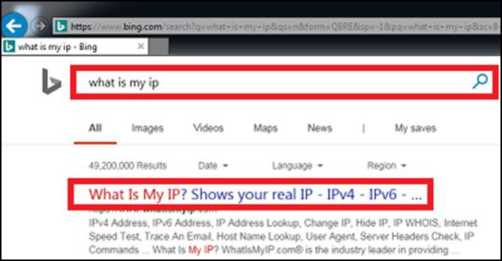
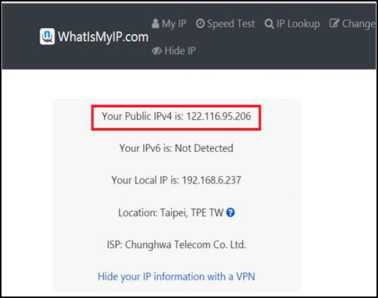
[General Mode]
- Tap the GV-Eye icon H on the desktop of your mobile device. This page appears.

- Tap the Add button ^]. This page appears.
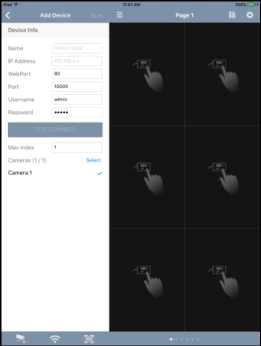
[Easy Mode]
1. Tap the GV-Eye icon H on the desktop of your mobile device. This page appears.
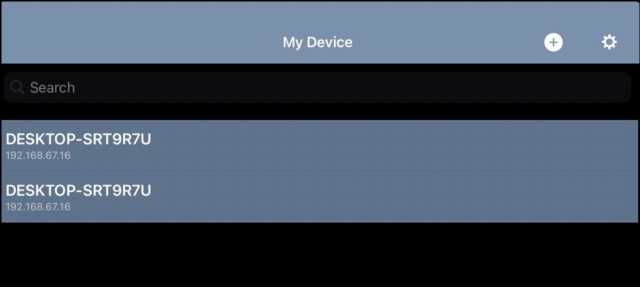
![]()
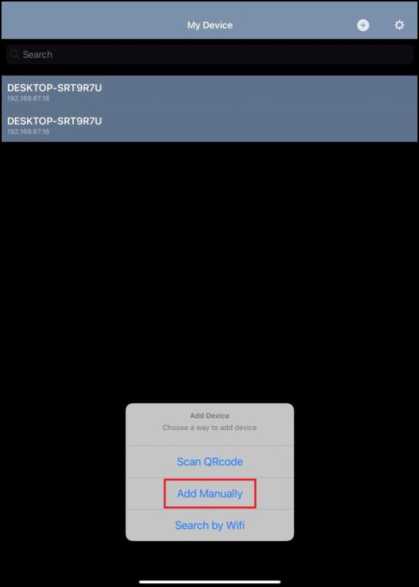
2.
and select Add Manually.
Tap the Add button
- On the Add Device page, enter the IP address, port number, username and password of the GV-IP device or software and enter a name.

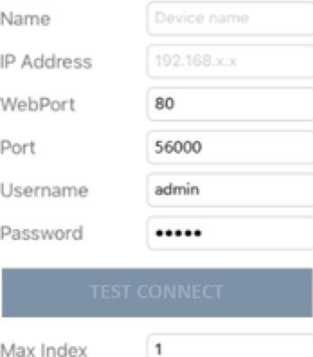 Type the local / public IP address or the domain name of the GV-IP device / software to which you want to connect, for within the LAN or through the Internet. For the public IP address, see Step 3, 6.3 Port Forwarding.
Type the local / public IP address or the domain name of the GV-IP device / software to which you want to connect, for within the LAN or through the Internet. For the public IP address, see Step 3, 6.3 Port Forwarding.
Camera 1
- Only modify the Web Port of 80, which is the default web port for all GV-IP device / software, when the corresponding web port on the device / software to which you want to connect has been changed.
- Type one of the below port values as Port, depending on the GV-IP device / software to which you want to connect.
| GV-IP devices (VSS Port) | 10000 |
| GV-Recording Server 1
Video Gateway Server |
11000 |
| GV-Mobile Server | 55000 |
| GV-VMS | 56000 |
| GV-DVR/NVR | 56000 |
| GV-SNVR | 10000 |
- Type the login Username and Password of the GV-IP device / software to which you want to connect.
- Tap Test Connect. The total number of cameras and each installed GV-IP Cameras are displayed.
- By default, all the installed cameras are selected. To change this setting, deselect the cameras by tapping the check marks next to the cameras, or tap Select to set the range of cameras to add.
- Tap Save on the top-right corner. The selected cameras are added to Camera List.
For automatic connection, GV-IP devices and software must be within the same LAN as your GV-Eye. For connecting to GV-Software, the related settings on the respective software must first be configured, see 6.1 Required Configurations on GV-Software before Connecting.
- Follow Step 1 to 2 in 6.4 Manual Connection to access the Add Device page.
[General Mode]
- Tap the WiFi icon Q below. GeoVision IP devices and software under the same LAN
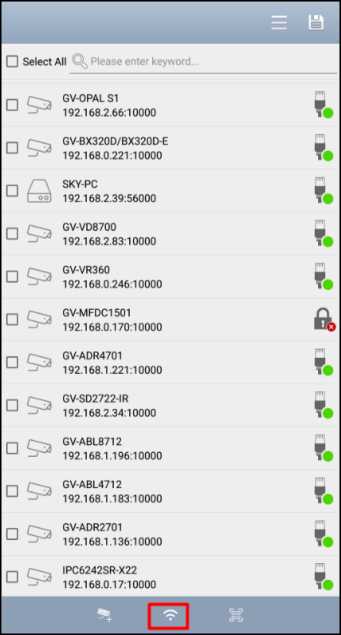
will be detected.
| Icon | Description |
|---|---|
| Logged in successfully | |
| ft | Incorrect login – tap to type the login Username and Password for the device |
- Select the desired GV-IP devices and software and tap Save LB
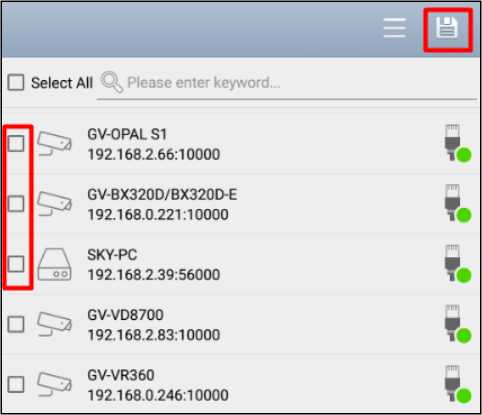
- To display a camera live view, tap and drag the camera from the Camera List to the live view grid you want.
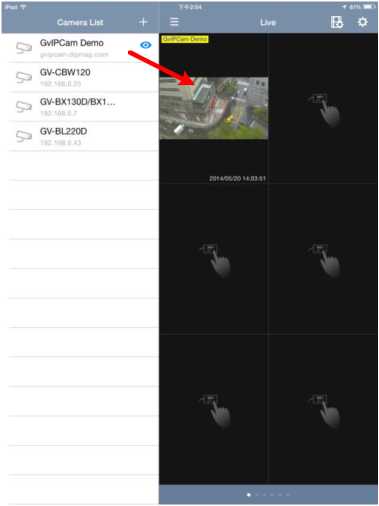
- To disconnect a live view, tap and hold the live view and drag the live view into the trash
can icon.
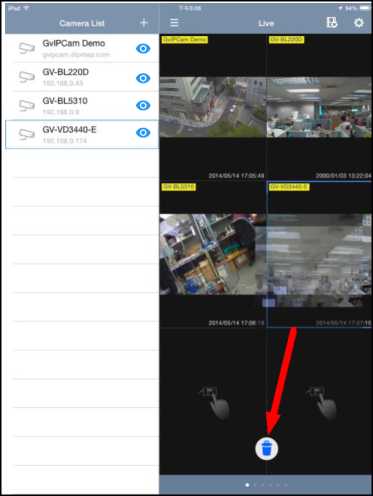
- To remove an entry from the Camera List, glide the entry to the left and tap Delete.
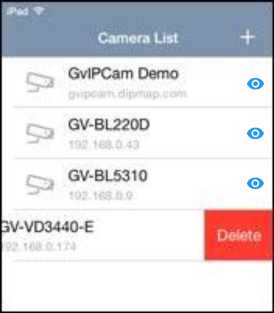
- To change the device information, tap the entry from the Camera List to modify. The
modified camera will be reconnected after you save the settings.
[Easy Mode]
- Tap Search by Wifi. GeoVision IP devices and software under the same LAN will be detected.
- Select the desired IP devices and type its ID and password.
Once connected, the live view of all channels will be displayed.
Follow the steps below to create up to 100 different groups for your GV-IP devices. Note that this function is only applicable under General Mode.
1. In the Settings page (No. 6, 4.1 General Mode), tap Group Management.

- On the Group Management page, tap Edit, and tap the name field to name the group.

- To choose layouts for each group, tap the > sign. There are 6 pages in total with each displaying up to 16 channels of live view.
Tap to save your settings
Tap to edit the name of the layout

Tap and scroll to select a layout template
Tap and hold to change the order of the pages
4. Return to the main page and select a desired group for adding IP devices.
Click to display the drop-down list of the group menu
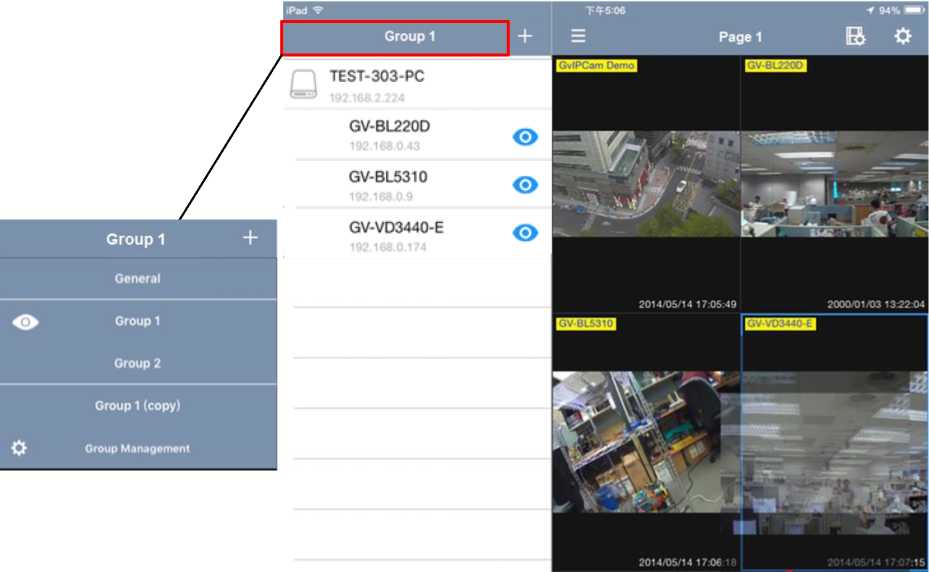
Tap any live view within the live view grid for a full-screen display as below.
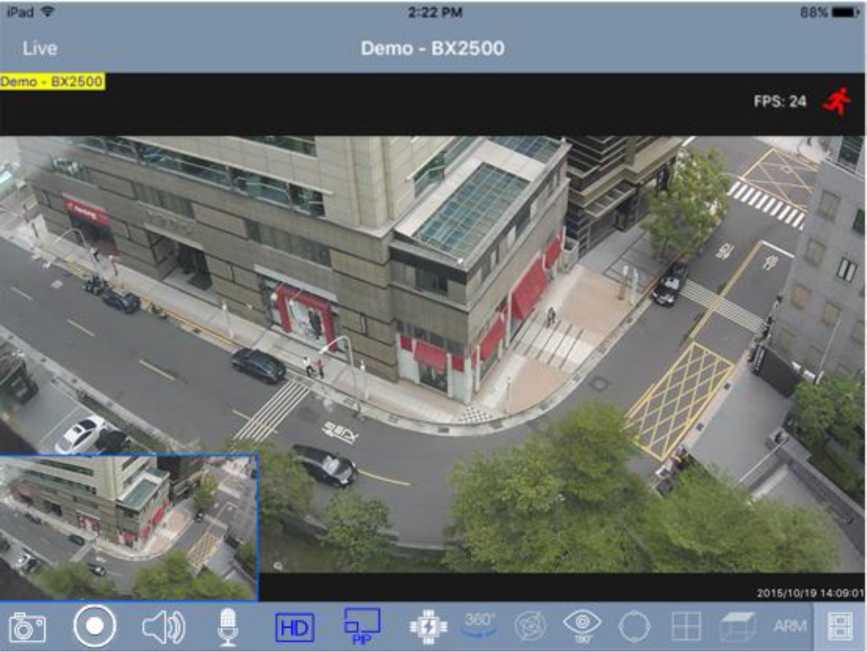
You can access the following functions by tapping the corresponding icon. When the functions are enabled, the record icon glows red while the others glow blue.
| Icon | Name | Function |
| Snapshot | Snapshots the current live view and saves it to the photos or gallery folder of your mobile device. | |
| Demo * 0X2500, | Camera Status | Starts the recording. A colored camera name at the upper-left corner of the live view indicates the status of the camera.
|
| Icon | Name | Function | ||
| ©/® | Record | Tap the button to enable or disable recording to the connected camera. | ||
| Speaker | Broadcasts sounds from the surveillance site. This function is enabled by default. | |||
| H | Microphone | Speaks to the surveillance site. This function is enabled by default. | ||
| [hd] | Stream Switch | Switches the connected stream. By default, stream 2 (with lower resolution) is connected. | ||
| PIP | Displays a picture-in-picture view which is a close-up view with its original view displayed in an inserted window. This function is enabled by default. On your mobile device, pitch to zoom the part of the live view you wish to examine. You can then glide on the screen to see the different parts of the close-up view. | |||
| PTZ Panel | Enables the PTZ control panel. You can control the camera view using the following:
wish to move the camera view
selecting a preset number |
|||
| Auto L J | Auto Focus | Automatically focuses the live view. This function is only accessible when the PTZ panel is enabled. | ||
| I / O Trigger | Manually triggers the output and edit the output naming displayed on your mobile device. | |||
Note:
- I / O Trigger does not support IP devices of the following models: GV-ABL2702 / ABL4712 / ABL8712 / AVD2700 / AVD4710 / AVD8710 / EBD4711 / EBD8711 / SD2322-IR / SD2722-IR / SD3732-IR / TDR2700 / TDR4700.
- To enable the microphone function for the following IP camera models, make sure to set the RTSP Authentication to Basic from Setup > Security > Network Security > Authentication on the cameras’ Web interface: GV-ABL / ADR / AVD / EBD / TBL / TDR / TFD / TVD Series, GV-BLFC5800, GV-EBFC5800, GV-FER5702, GV-PTZ5810-IR, SD2322-IR / SD2722-IR / SD3732-IR / SD4825-IR / SD4834-IR.
| Icon | Name | Function | ||
| 360° Mode | Displays the live view of a camera in panoramic view. You can swipe fingers on the screen in every direction to explore a 360° video. This function is disabled by default. Enables 360° View in the Settings page (see 11. System Settings), and the icon will be added on the live view.
Note: The 360° Mode needs to work with GV-VR360 Camera. |
|||
| 360° | VR Mode | Switch the display mode of camera live view between
360° Mode or VR head set view Iciol This function is |
||
| disabled by default. Taps 360° Mode and the icon will
be added on the live view. Note: The VR Mode needs to work with GV-VR360 Camera. |
||||
| Gyroscopic Mode | Allows the live image to rotate with the movement of a mobile device, such as a VR head set. This function is disabled by default. Taps 360° Mode , and the icon will be added on
the live view. Note: The Gyroscopic Mode needs to work with GV-VR360 Camera. |
| Icon | Name | Function | ||
| Fisheye Dewarp | Dewarps the fisheye live view and allows users to align the live view, select display mode and define the installation type.
For details, see Image Alignment, Display Mode and Installation Type in this table. |
|||
| <©>
180′ |
||||
| s | Image
Alignment |
Defines the size and center of the Fisheye view. Tap to enable this function and then enlarge, minimize and move the red circle. Tap this icon again to apply the setting. | ||
| © | Display Mode | Defines the display mode of a GV-Fisheye Camera.
Single View: shows one PTZ view |
||
| Installation Type | Defines the installation type of a GV-Fisheye Camera. Tap the icon and select among:
|
|||
| Alarm
Notification |
Enable the alarm notification to GV-Center V2 when events occur. This function is disabled by default. Enable ARM & E-mail in the Settings page (see 11. System Settings ), and the icon will be added on the live view. This function is only available for General Mode.
Note: The notification settings should be configured in advance on GV-IP Cameras. |
|||
| ARM | ||||
| E-mail
Notification |
Enable the function of receiving alert notification through e-mails when events occur. This function is disabled by default. Enable ARM & E-mail in the Settings page (see 11. System Settings), and the icon will be added on live view. This function is only available for General Mode.
Note: The notification settings should be configured in advance on GV-IP Cameras. |
|||
| B | ||||
| Playback | Plays back recordings. For details, see 9. Playing Back Recordings later in this installation guide. | |||
| □ | Motion
Detection |
Indicates detected motions. The icon becomes red 1 when a motion is detected. | ||
| □ | Hardware
Decode |
Enables GPU decoding which lowers the CPU loading and increases the smoothness of live view. This function is only available for General Mode. | ||
| FPS | Indicates the number of frames per second, ranging from 0 to 30. The more frames per second, the smoother the motion appears. | |||
| FPS: 2 | ||||
Note:
- The control of enabling or disabling recording EO is only available for compatible products and versions. For details, see 2.2 Supported Products for Enabling Recording.
- PTZ Panel functions are fully or partially supported by the following GV-IP device:
- GV-IP Speed Dome and GV-PTZ Camera: all functions supported
- GV-PT Camera: all functions supported except zoom in / out
- GV-IP Cameras that support remote focus / zoom adjustment: only support auto focus, focus in / out and zoom in / out.
- The microphone function is only supported by GV-IP Cameras and GV-Recording Server V1.3 or later.
- Playing Back Recordings
Make sure the following functions are enabled ahead to allow remote access from GV-Eye:
- GV-DVR / NVR / GV-VMS: enable Remote ViewLog Service. See 6.1 Required Configurations on GV-Software before Connecting.
- GV-IP Camera / GV-Video Server / GV-Compact DVR: enable ViewLog Server
Note:
- If a router or firewall is installed with the remote servers and IP devices, ensure the corresponding playback port is open. For example, to play back the files from GV-DVR / NVR / VMS, open port 5552 on the router. For Windows Firewall settings see 6.2 Configuring Windows Firewall for Communication. For port forwarding and a full list of default port numbers, see 6.3 Port Forwarding.
- To enable the Audio function for playback in GV-Eye, you must activate related Audio Settings in hosts.
GV-VMS: Setup > Audio Setting > enable Rec Audio and Round-the-Clock Audio options.
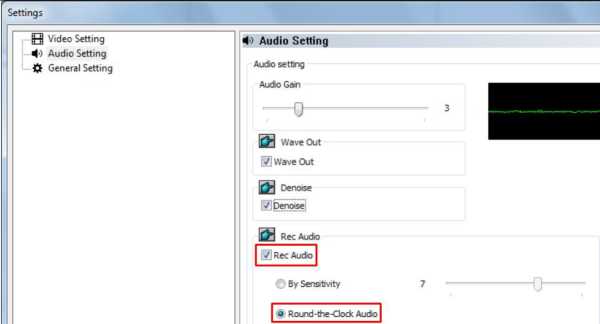
GV-DVR: Configure > A/V Settings > Audio Settings > enable Rec Audio and Round-the-Clock Audio options.
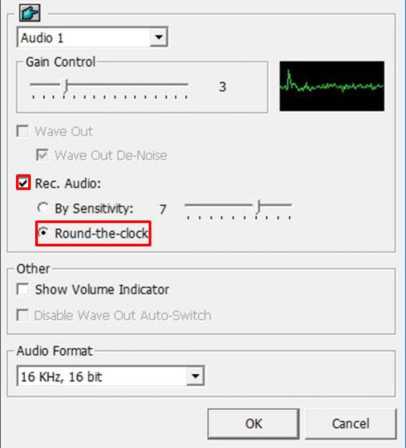
GV-SNVR0400F/0411/0811/0812/1600/1611/1612: Camera Settings > enable Audio.
- The following models with recordings saved on the SD card do not support playback from the local storage: GV-ABL / TBL Series, GV-ADR / TDR Series, GV-AVD / TVD Series, GV-BLFC5800, GV-EBD Series, GV-EBFC5800, GV-FER5702, GV-PTZ5810-IR, GV-SD2322-IR / SD2722-IR / SD3732-IR / SD4825-IR / SD4834-IR, GV-TFD Series, UA-B580F3, and UA-IP cameras.
- GV-Eye only supports single-channel playback.
- A maximum of two GV-Eye connections are supported at a time for remote playback for the following UA-SNVR / HD DVR models: UA-SNVRL810-P, UA-SNVR1620-P, UA-XVL810 / 1610, and UA-XVR810 / 1620.
To access the recorded files:
1. From the live view page, tap n. This page appears.

Note: The date and time marked with the asterisk (*) symbol indicates its daylight saving time (DST).
- The recording files of the day are listed. Tap to select up to five videos. Tap to start
playing.
- You can also tap the calendar icon |g] to view the recording status.

The full-screen display is as below.
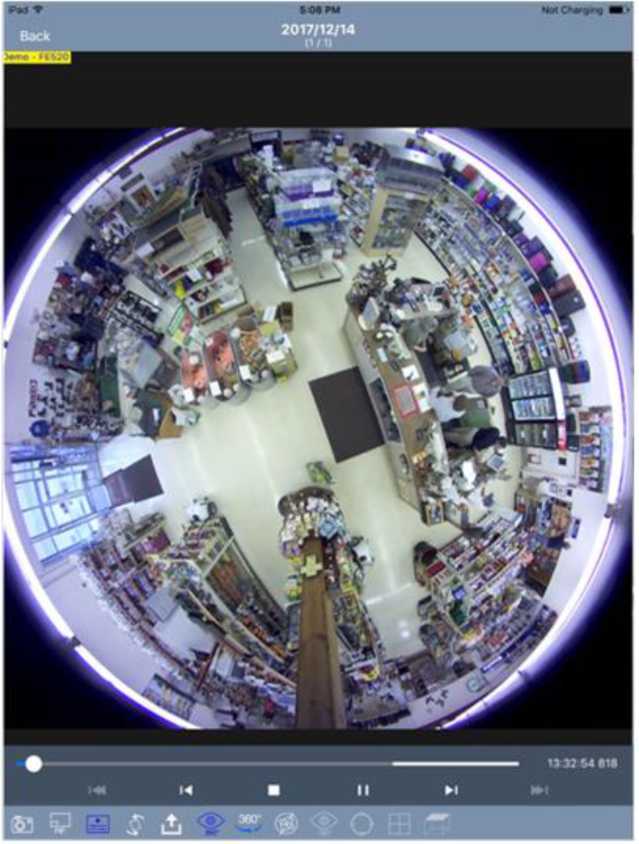
You can access the following functions by tapping the corresponding icon. With the functions enabled, the icons glow blue.
| Icon | Name | Function |
| Export | Saves the .mp4 playback file when it is ready and share it with smartphone apps available on your mobile device. | |
| Snapshot | Snapshots the current playback and saves it to the photos or gallery folder of your mobile device. | |
| 1 C ‘ | ||
| Icon | Name | Function | ||
| PIP | Displays a picture-in-picture view which is a close-up view with its original view displayed in an inserted window. This function is enabled by default. On your mobile device, pitch to zoom the part of the playback you wish to examine. You can then glide on the screen to see the different parts of the close-up view. | |||
| | | Hide Control Bar | Hides the control bar on the playback window so that the users can get a full view of the playback display. | ||
| Rotate | Rotates the playback display by 90° for each tap. | |||
| Fisheye Dewarp | Dewarps the fisheye live view and allows users to align the playback scenes, select display mode and define the installation type. For details, see Image Alignment, Display Mode and Installation Type in this table. | |||
| 180” | ||||
| 360° Mode | Displays the live view of a camera in panoramic view. You can swipe fingers on the screen in every direction to explore a 360° video. This function is disabled by default. Enables 360° View in the Settings page (see 11. System Settings), and the icon will be added on the live view.
Note: The 360° Mode needs to work with GV-VR360 Camera. |
|||
| <©> 3B0′ | ||||
| VR Mode | Switch the display mode of camera live view between | |||
| 360° | ||||
| 360° Mode or VR head set view IckiI This function is | ||||
| disabled by default. Taps 360° Mode and the icon will be
added on the live view. Note: The VR Mode needs to work with GV-VR360 Camera. |
||||
| Icon | Name | Function |
| n | Gyroscopic Mode | Allows the live image to rotate with the movement of a mobile device, such as a VR head set. This function is disabled by default. Taps 360° Mode , and the icon will be added on
the live view. Note: The Gyroscopic Mode needs to work with GV-VR360 Camera. |
| Image
Alignment |
Defines the size and center of the Fisheye view. Tap to enable this function and then enlarge, minimize and move the red circle. Tap this icon again to apply the setting. | |
| @1 | Display Mode | Defines the display mode of a GV-Fisheye Camera.
|
| Installation Type | Defines the installation type of a GV-Fisheye Camera. Tap the icon and select among:
|
The Edge settings section allows you to configure the IP address, device name and storage path for GV-IP devices. Note that the settings are only available for General Mode.
To access the settings, enable Edge Tool in the Settings page (see 11. System Settings), and the Edge settings button m will be added on the main page. Tap m and the Edge settings page appears.
IP Name HDD Storage
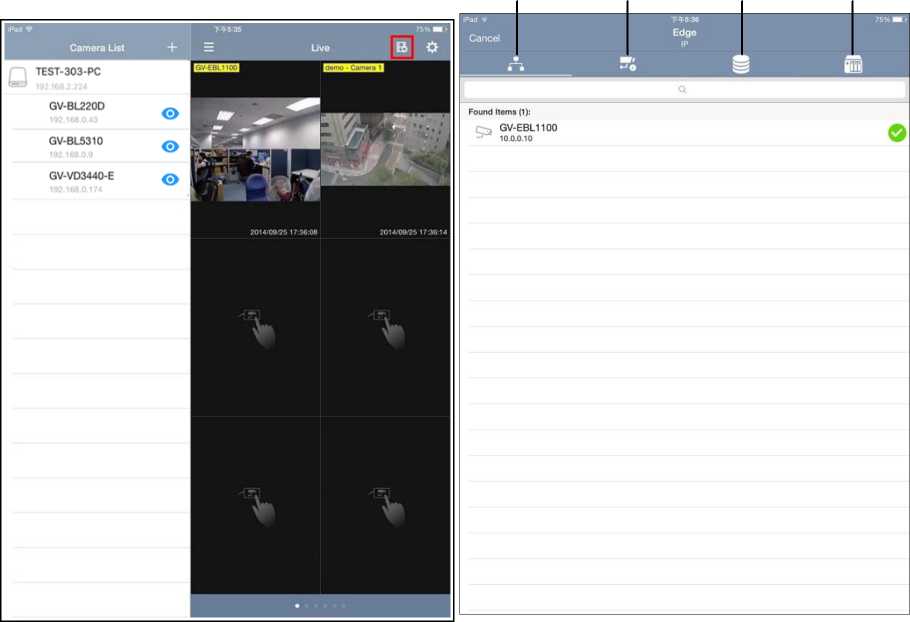
Main Page
Edge Settings Page
Note: For Android devices, tap u on the main page and tap Edge Tool to access the
Edge settings.
To change the IP address of a GV-IP Device, follow the steps below.
Note: The function of changing IP address is only supported by compatible GV-IP Camera, GV-Video Server and GV-Compact DVR.
- On the IP settings page, select the desired GV-IP Device. A green tick appears under camera name.
- Tap Next at the upper-right corner. This page appears.
| iPad
< Back |
T^12:22
IP |
37% ■ ■
Save |
| Advanced ▼
IP |
192.168.0.1 | |
| Selected Items (1): GV-EBL1100 10.0.0.10 | —► 192.168.1.10 |
- Type a new IP address and optionally tap the Advanced button to configure the Mask,
Gateway and DNS settings.
| iPad | T*F5:36 | 74% Mi j |
| < Back | IP | Save |
Advanced ▲
IP 192.168.0.1
Mask
Gateway
DNS
Selected Items (1):
GV-EBL1100
—► 10.0.0.10
- Tap Save to enable the settings.
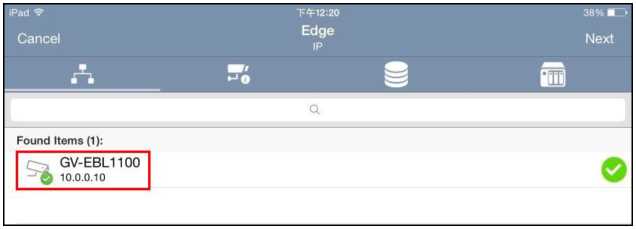
To change the device name of a GV-IP Device, follow the steps below.
Note: The function of changing device name is only supported by compatible GV-IP Camera, GV-Video Server and GV-Compact DVR.
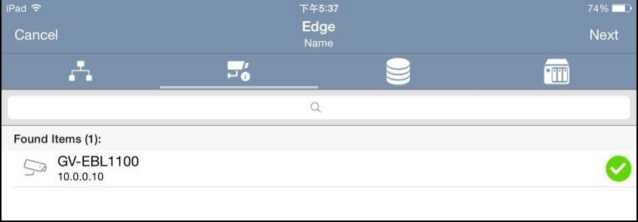
 1.
1.
On the Edge settings page, tap the Name button Hiki. The Name settings page appears.
2. Select the desired GV-IP Device and tap Next. This page appears.
3. Type a new name for the device and tap Save.
- On the Name settings page, pull to refresh. The device name is updated.


Found Items (1):
GV-EBL1100-demo 10.0.0.10
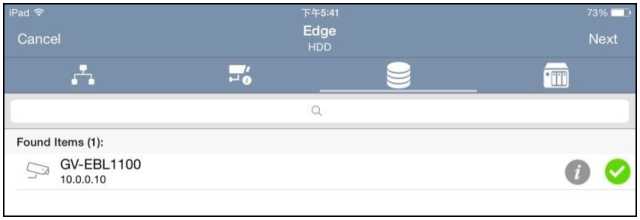

On the Edge settings page, tap the HDD button . The HDD settings page appears.
2. Select the desired camera and tap Next. This page appears.
To assign the recording storage path on GV-NAS System for a GV-IP Camera, follow the steps below.
Note:
- Make sure the camera stops recording before assigning storage path.
- This function is only supported by GV-IP Camera firmware V3.0 or later and GV-Target IP Camera firmware V1.02 or later.
- The Edge recording is only supported by GV-NAS Systems.
1.
- Tap the Edit button and select Yes in the pop-up dialog box to add a valid path.
rNo valid path exists.
Do you want to add hosts now?
No Yes
- In the pop-up Host List, select the desired host, type the username and password of the host and tap Login.
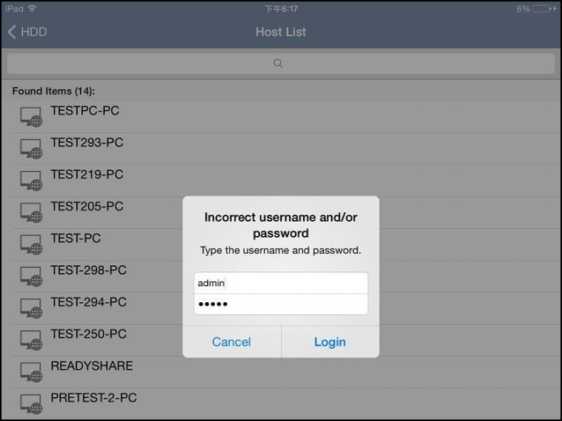
- In the pop-up Storage Path List, select the desired storage path, type a name and tap Save.
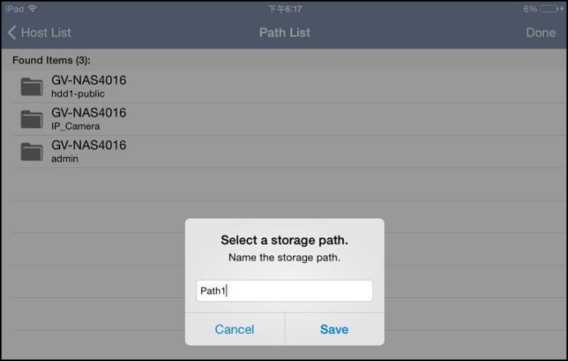
![]()
![]()
![]()
T^6:18 Edge Storage
- To view the added storage path, on the Edge settings page, tap the Storage button
The added path is displayed.
IPad
Cancel
Q
Found Items (1):
B
Pathl
//GV- NAS4016/I P_Camera
To view the HDD storage status, tap the Info button O on the HDD settings page. The HDD Info page appears and displays the capacity.

Note:
- This function is only supported by GV-IP Camera firmware V3.0 or later and GV-Target IP Camera firmware V1.02 or later.
- For the camera with its storage path being assigned on the GV-NAS System, the HDD Info page displays the NAS storage capacity; for the camera without storage path assigned, the HDD Info page displays the SD card storage capacity.
- System Settings
To access GV-Eye settings, tap □ on the main page. The settings page appears.
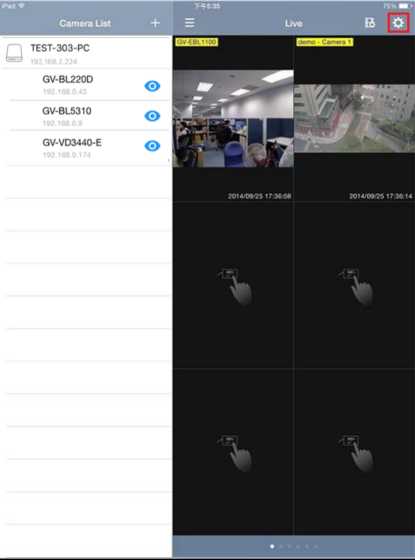
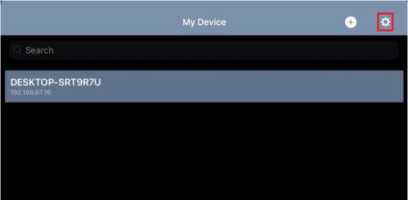
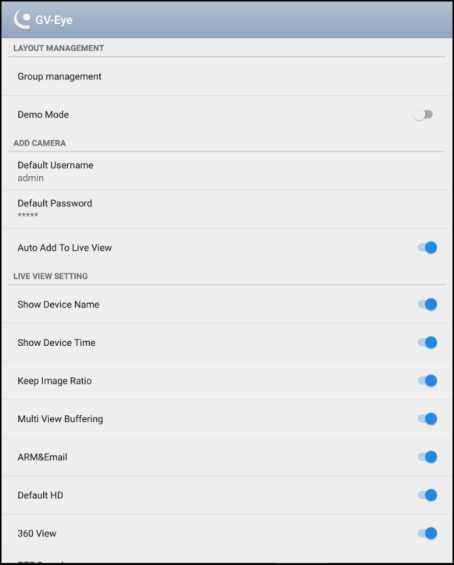
Main Page (General Mode)
Main Page (Easy Mode)
Settings Page
[LAYOUT MANAGEMENT]
- Group Management: Creates groups and arranges live view layouts. GV-Eye can receive up to 96 channels of live view from various GV-IP devices. Users can create up to 100 groups, and each group has 6 pages in total with each displaying up to 16 channels of live view. See 7. Group Management for details.
- Demo Mode: Displays 3 channels of live view for you to experience the features of GV-Eye.
Note: If you enable Demo Mode, your current connection of IP-devices and layout settings of live view will be temporarily closed. Instead, 3 demo channels and default layout will be displayed. To resume your previous settings, disable Demo Mode.
[ADD CAMERA]
- Default Username: Sets the default username when adding a new IP device to the Camera List. The default is admin.
- Default Password: Sets the default password when adding a new IP device to the Camera List. The default is admin.
- Auto Add to Live View: Automatically displays the added IP devices to live view. This function is disabled by default.
[LIVE VIEW SETTING]
- Show Device Name: Displays device name on live view.
- Show Device Time: Displays device time on live view.
- Keep Image Ratio: Displays the live view in proportion to the device’s resolution.
- Multi View Buffering: Enhances the smoothness of live view with multiple divisions. Note this function is for Android devices only.
- ARM & EMAIL: Displays the alarm invocation and e-mail notification icons on live view.
- Default HD: Displays the live view in HD quality video. This function is enabled by default.
- 360 View: Enables the panoramic view.
- PTZ Speed: Changes the PTZ speed. Speed 1 is the slowest and speed 5 the fastest.
- *Delete All Entries on Camera List: Click to delete all the entries from the Camera List of all groups.
- *Export Camera List: Export the current camera list as a QR code image to the internal storage of smartphone.
- *Import Camera List: Scan the QR code containing the camera list, previously exported, to be loaded into GV-Eye. Select Append to import a new camera list along with the existing one. Select Replace to replace all existing camera list with the newly imported list.
- Edge Tool: Displays the edge settings icon on live view.
[ACCOUNT MANAGEMENT]
- *Add a binding account: Logs into a GV-Relay Account, see 5. GV-Relay QR Code.
[PLAYBACK SETTING]
- *Audio: Enable Audio function for video playback.
- Hardware Acceleration: Enable Hardware Acceleration function to increase the smoothness of playback. Note this function is enabled by default and for Android devices only.
[SYSTEM SETTING]
- *Disable Screen Off: Turns off sleep mode of the mobile device when the GV-Eye is running.
Note: Under Easy Mode, only the functions marked with the asterisk (*) symbol are available.
In GV-VMS, you can alter user privileges to determine which user account can access Video, Audio, PTZ, Monitor Start / Stop and I / O Output Control from mobile app GV-Eye.
Note: The function is only supported by GV-VMS V16.10.3 or later.
To set up the user privilege:
- Click Home click the account ID, click Password Setup, and select Local Account
Edit and select the Web / Mobile tab.
- Select or deselect Video, Audio, PTZ, Monitor Start / Stop and I / O Output Control of specific cameras to allow or deny the user the function.
For instance, firstly, on the Local Account Edit dialog box of GV-VMS, you can deny User1
the access of PTZ. Then, when you log on GV-Eye with the ID and password of User1,
you will see that User1 cannot access PTZ on GV-Eye.
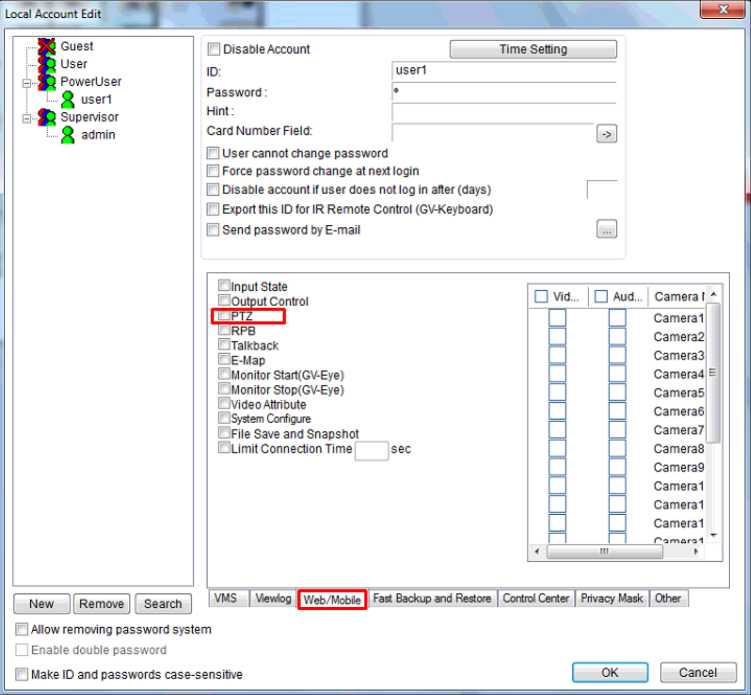
GV-Authentication Server is a central credential management system for you to manage multiple GV-VMS or GV-DVR / NVR systems. By connecting to GV-Authentication Server, you can access the cameras from multiple GV-VMS or GV-DVR / NVR systems with one Authentication user account on GV-Eye.
Note:
- Other device connection functions on GV-Eye will be disabled while connecting to GV-Authentication Server.
- This is only applicable to GV-Eye for iOS / Android V2.8 or later (under General Mode) and GV-Authentication Server V18.3 or later.
To create clients / user accounts in GV-Authentication Server:
- To create a GV-Eye client, highlight Client List from the left pane and click Add A Client button.
- To create one Authentication user account that has access rights to assigned GV-VMS or GV-DVR / NVR systems, select Account Setup > Password Setup. Refer to Creating User Accounts, 11.5 Authentication Server in GV-DVR / NVR User’s Manual, or 9.4 Authentication Server in GV-VMS User’s Manual.
3. Click the Start Service button on GV-Authentication Server.
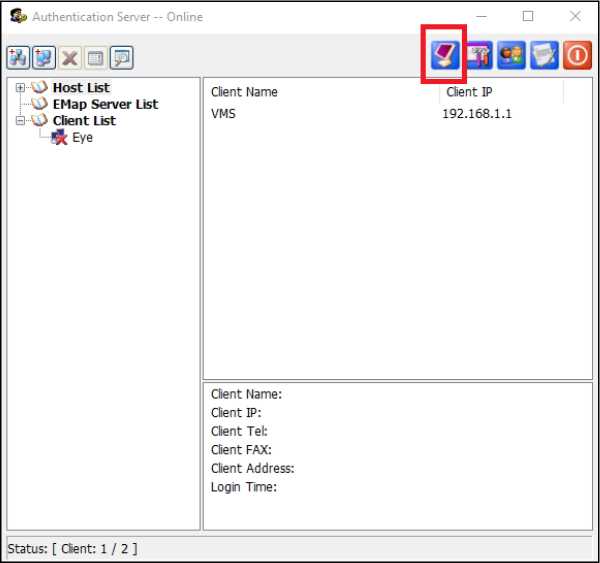
To connect to GV-Authentication Server:
For iOS users
- Click Settings □ > Auth Server. The following page appears.
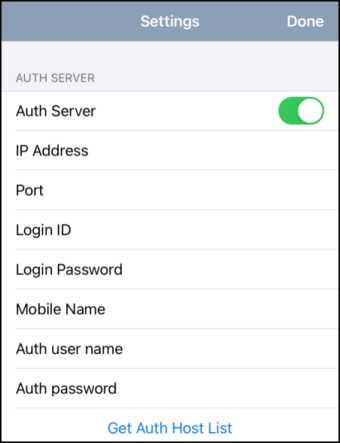
For Android users
- Click Settings □ > Demo Mode > Auth Service Mode. The following page appears.
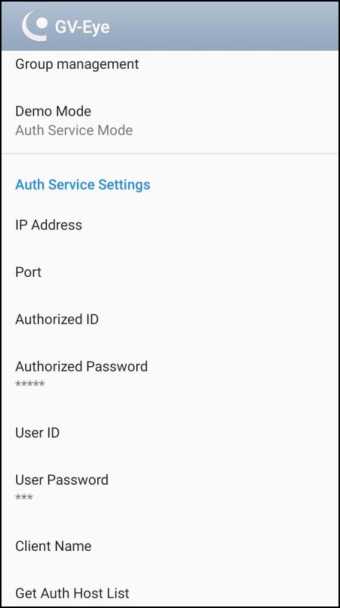
- Type IP Address, Port, Authorized ID, and Authorized Password of GV-Authentication Server.
- Type the following connection information:
- Client Name: Type the client name you have created on GV-Authentication Server.
- User ID / User Password: Type the ID and password of the user account you have created on GV-Authentication Server.
- Select Get Auth Host List.
After GV-Authentication Server is successfully connected, you will be able to access the cameras from multiple GV-VMS or DVR / NVR systems assigned to the Authentication user account. You can proceed with desired configurations on these cameras.
